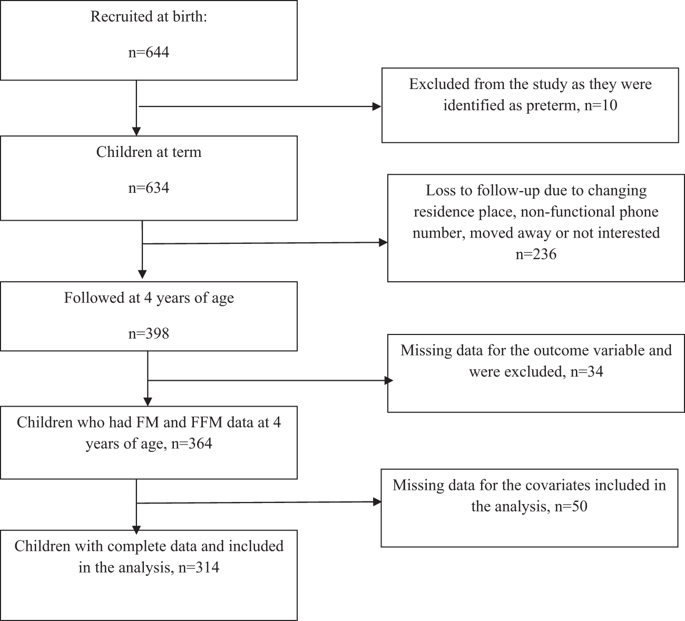Nutrition & Diabetes ( IF 6.1 ) Pub Date : 2018-09-07 , DOI: 10.1038/s41387-018-0056-7 Bitiya Admassu 1, 2 , Jonathan C K Wells 3 , Tsinuel Girma 4 , Tefera Belachew 1 , Christian Ritz 2 , Victor Owino 5 , Mubarek Abera 2, 6 , Rasmus Wibaek 2, 7 , Kim F Michaelsen 2 , Pernille Kæstel 2 , Henrik Friis 2 , Gregers S Andersen 7

|
Background/Objectives
Low and high birth weight and rapid weight gain during infancy are associated with childhood obesity. Associations of birth and infancy body composition (BC) growth with childhood BC remain unknown in low-income countries. We aimed to investigate the associations of fat mass (FM) and fat-free mass (FFM) at birth and its accretion during early infancy with FM and FFM at the age of 4 years.
Methods
In the infant Anthropometry and Body Composition (iABC) cohort, BC was assessed at six consecutive time points from birth to 6 months and at 4 years of age by air displacement plethysmography. Multiple linear regression models were used to determine the association between FM and FFM at birth and their accretion rates during infancy and FM index (FMI) and FFM index (FFMI) at 4 years in 314 children.
Results
One kilogram higher FFM at birth was associated with a 1.07 kg/m2 higher FFMI (95% CI 0.60, 1.55) at 4 years while a one SD increment in FFM accretion rate from 0 to 6 months was associated with a 0.24 kg/m2 increment in FFMI (95% CI 0.11, 0.36) and with a 0.20 kg/m2 higher FMI at 4 years (β = 0.20; 95% CI 0.04, 0.37). FFM at birth did not predict FMI at 4 years. FM at birth was associated with 1.17 kg/m2 higher FMI at 4 years (95% CI 0.13, 2.22) whereas FM accretion from 0 to 4 months was associated with an increase in FMI of 0.30 kg/m2 (95% CI 0.12, 0.47). FM at birth did not predict FFMI at 4 years, and neither did FM accretion from 0 to 4 months.
Conclusions
A higher FFM in early infancy predicted higher FFMI at 4 years while a higher FM accretion during early infancy predicted higher FMI at 4 years. Follow-up studies are merited to explore associations of childhood BC with cardio-metabolic risk later in life.
中文翻译:

埃塞俄比亚前瞻性队列研究 Jimma 婴儿早期的身体成分及其与 4 岁时身体成分的关系
背景/目标
低出生体重和高出生体重以及婴儿期体重快速增加与儿童肥胖有关。在低收入国家,出生和婴儿期身体成分 (BC) 生长与儿童期 BC 之间的关系仍然未知。我们的目的是调查出生时的脂肪量 (FM) 和去脂体重 (FFM) 及其在婴儿早期的增加与 4 岁时的 FM 和 FFM 之间的关系。
方法
在婴儿人体测量和身体成分 (iABC) 队列中,通过空气置换体积描记法在从出生到 6 个月以及 4 岁时的连续六个时间点评估 BC。使用多元线性回归模型确定 314 名儿童出生时 FM 和 FFM 与其婴儿期累积率以及 4 岁时 FM 指数 (FMI) 和 FFM 指数 (FFMI) 之间的关联。
结果
出生时 FFM 增加 1 公斤与 4 岁时 FFMI 增加 1.07 kg/m 2 相关(95% CI 0.60, 1.55),而 0 至 6 个月 FFM 增加率每增加 1 个 SD 与 0.24 kg/m 2增加相关2 FFMI 增量(95% CI 0.11, 0.36), 4 年时 FMI 增加0.20 kg/m 2 ( β = 0.20;95% CI 0.04, 0.37)。出生时的 FFM 并不能预测 4 岁时的 FMI。出生时的 FM 与 4 岁时 FMI 增加 1.17 kg/m 2相关(95% CI 0.13, 2.22),而 0 至 4 个月的 FM 增加与 FMI 增加 0.30 kg/m 2相关(95% CI 0.12) ,0.47)。出生时的 FM 不能预测 4 岁时的 FFMI,0 至 4 个月期间的 FM 增长也不能预测。
结论
婴儿早期较高的 FFM 预示着 4 岁时较高的 FFMI,而婴儿早期较高的 FM 积累预示着 4 岁时较高的 FMI。后续研究值得探索儿童 BC 与以后生活中心脏代谢风险的关系。



























 京公网安备 11010802027423号
京公网安备 11010802027423号